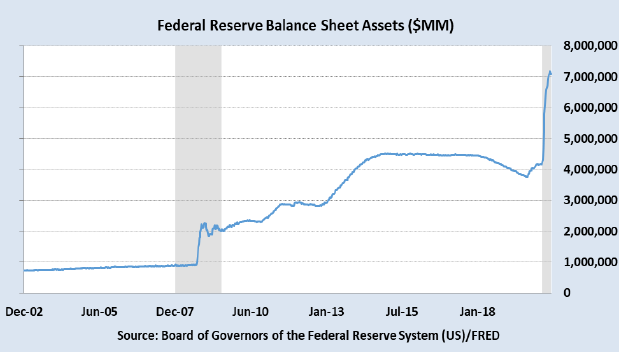
THE FED’S DECIDEDLY UNBALANCED BALANCE SHEET
In response to the vast economic turmoil due to COVID-19, the Federal Reserve has doubled the assets on its balance sheet over the last few months to more than $7 trillion. As illustrated in the chart below, this marks the third such doubling of the Fed’s balance sheet since the Great Recession of 2008-09. The balance sheet total is now tenfold what it was in the mid-2000s, far above any historical precedent in terms of its pace of growth. Although flooding the economy with such a huge injection of liquidity has at least somewhat cushioned the
blow from the pandemic, such actions do have a downside, for they become increasingly harder to unwind once economic conditions improve.
To be sure, these interventions usually are completely justified and helpful when undertaken. Indeed, like this most recent wave of asset purchases by the Fed, that first doubling in 2008 was absolutely needed to stabilize the economy, which, at that time, was blindsided by the massive shock to and near-total meltdown of credit markets as banks became increasingly unwilling to lend both to their customers and to each other. The Fed stepped in to provide enough liquidity to banks to assure markets that plenty of money would be available to anyone who needed it. Consequently, the markets calmed down, and things slowly but surely returned to normal.
However, these moves can pose a moral hazard laying the groundwork for a financial collapse more significant than would occur if they were not made in the first place. For example, the 2008 easing prevented market forces from fully cleansing the system of poor decisions and policy.
The Fed tried to start backing off its purchasing binge and reduce its balance sheet in 2013, but the stock and bond markets threw a “taper tantrum” in response. Electing to coddle them, the Fed not only refrained from unloading its assets but also added another $1 trillion to double its balance sheet a second time, further signaling that it would continue to feed the easy-credit addiction.
Many countries throughout history have tried to borrow and spend their way out of trouble, only to suffer dearly down the road. (The ongoing struggles of Greece that started in the last decade readily come to mind.) Amid market expectations that the Fed’s balance sheet is well on its way to $10-12 trillion, arguably the only sound and sustainable remedy is to reduce borrowing and spending to levels
more aligned with actual revenues and economic growth. The U.S. certainly can do that, but whether it wants to is the question that matters. If it does not, the markets may impose their will at some point, making recovery much more painful.